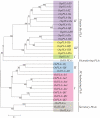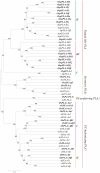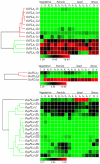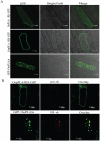Rice phospholipase A superfamily: organization, phylogenetic and expression analysis during abiotic stresses and development
- PMID: 22363522
- PMCID: PMC3281901
- DOI: 10.1371/journal.pone.0030947
Rice phospholipase A superfamily: organization, phylogenetic and expression analysis during abiotic stresses and development
Abstract
Background: Phospholipase A (PLA) is an important group of enzymes responsible for phospholipid hydrolysis in lipid signaling. PLAs have been implicated in abiotic stress signaling and developmental events in various plants species. Genome-wide analysis of PLA superfamily has been carried out in dicot plant Arabidopsis. A comprehensive genome-wide analysis of PLAs has not been presented yet in crop plant rice.
Methodology/principal findings: A comprehensive bioinformatics analysis identified a total of 31 PLA encoding genes in the rice genome, which are divided into three classes; phospholipase A(1) (PLA(1)), patatin like phospholipases (pPLA) and low molecular weight secretory phospholipase A(2) (sPLA(2)) based on their sequences and phylogeny. A subset of 10 rice PLAs exhibited chromosomal duplication, emphasizing the role of duplication in the expansion of this gene family in rice. Microarray expression profiling revealed a number of PLA members expressing differentially and significantly under abiotic stresses and reproductive development. Comparative expression analysis with Arabidopsis PLAs revealed a high degree of functional conservation between the orthologs in two plant species, which also indicated the vital role of PLAs in stress signaling and plant development across different plant species. Moreover, sub-cellular localization of a few candidates suggests their differential localization and functional role in the lipid signaling.
Conclusion/significance: The comprehensive analysis and expression profiling would provide a critical platform for the functional characterization of the candidate PLA genes in crop plants.
Conflict of interest statement
Figures








Similar articles
-
Comprehensive expression analysis of rice phospholipase D gene family during abiotic stresses and development.Plant Signal Behav. 2012 Jul;7(7):847-55. doi: 10.4161/psb.20385. Epub 2012 Jul 1. Plant Signal Behav. 2012. PMID: 22751320 Free PMC article.
-
The phytocyanin gene family in rice (Oryza sativa L.): genome-wide identification, classification and transcriptional analysis.PLoS One. 2011;6(10):e25184. doi: 10.1371/journal.pone.0025184. Epub 2011 Oct 3. PLoS One. 2011. PMID: 21984902 Free PMC article.
-
ZINC-INDUCED FACILITATOR-LIKE family in plants: lineage-specific expansion in monocotyledons and conserved genomic and expression features among rice (Oryza sativa) paralogs.BMC Plant Biol. 2011 Jan 25;11:20. doi: 10.1186/1471-2229-11-20. BMC Plant Biol. 2011. PMID: 21266036 Free PMC article.
-
Genome-wide expression analysis of phospholipase A1 (PLA1) gene family suggests phospholipase A1-32 gene responding to abiotic stresses in cotton.Int J Biol Macromol. 2021 Dec 1;192:1058-1074. doi: 10.1016/j.ijbiomac.2021.10.038. Epub 2021 Oct 14. Int J Biol Macromol. 2021. PMID: 34656543 Review.
-
Metabolic and physiological functions of Patatin-like phospholipase-A in plants.Int J Biol Macromol. 2025 Jan;287:138474. doi: 10.1016/j.ijbiomac.2024.138474. Epub 2024 Dec 5. Int J Biol Macromol. 2025. PMID: 39645102 Review.
Cited by
-
Genomics and transcriptomics to protect rice (Oryza sativa. L.) from abiotic stressors: -pathways to achieving zero hunger.Front Plant Sci. 2022 Oct 20;13:1002596. doi: 10.3389/fpls.2022.1002596. eCollection 2022. Front Plant Sci. 2022. PMID: 36340401 Free PMC article. Review.
-
Characterization of stress and methylglyoxal inducible triose phosphate isomerase (OscTPI) from rice.Plant Signal Behav. 2012 Oct 1;7(10):1337-45. doi: 10.4161/psb.21415. Epub 2012 Aug 20. Plant Signal Behav. 2012. PMID: 22902706 Free PMC article.
-
Comparative phylogenomic and structural analysis of canonical secretory PLA2 and novel PLA2-like family in plants.Front Plant Sci. 2023 Feb 23;14:1118670. doi: 10.3389/fpls.2023.1118670. eCollection 2023. Front Plant Sci. 2023. PMID: 36909415 Free PMC article.
-
GhAAO2 was observed responding to NaHCO3 stress in cotton compared to AAO family genes.BMC Plant Biol. 2022 Dec 20;22(1):603. doi: 10.1186/s12870-022-03999-7. BMC Plant Biol. 2022. PMID: 36539701 Free PMC article.
-
Ethylene-Inhibited Jasmonic Acid Biosynthesis Promotes Mesocotyl/Coleoptile Elongation of Etiolated Rice Seedlings.Plant Cell. 2017 May;29(5):1053-1072. doi: 10.1105/tpc.16.00981. Epub 2017 May 2. Plant Cell. 2017. PMID: 28465411 Free PMC article.
References
-
- Munnik T, Meijer HJ. Osmotic stress activates distinct lipid and MAPK signalling pathways in plants. FEBS Lett. 2001;498:172–178. - PubMed
-
- Yamaguchi-Shinozaki K, Shinozaki K. Transcriptional regulatory networks in cellular responses and tolerance to dehydration and cold stresses. Annu Rev Plant Biol. 2006;57:781–803. - PubMed
Publication types
MeSH terms
Substances
LinkOut - more resources
Full Text Sources
Other Literature Sources
Molecular Biology Databases

